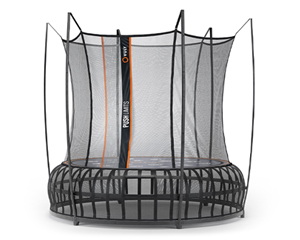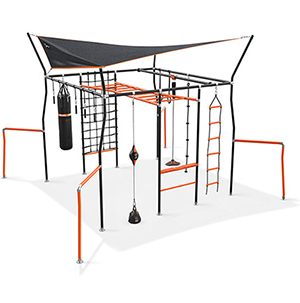Studies reveal that only 24% of children ages 6 to 17 participate in 60 minutes of physical activity on a daily basis—proving that many kids aren’t getting the right amount of exercise needed to stay healthy.
In this technology-centred era, inspiring kids to put down their digital entertainment can often seem like a task that comes with a "mission impossible" label. Getting them to enjoy the outdoors instead and improve their fitness isn't always easy—but it's absolutely necessary.
Physical Activity Recommendations (Australian Health Department)
| Age Group | Physical Activity | Sedentary Recreational Screen Time |
|---|---|---|
| Under 12 months | Interactive floor-based play, and at least 30 minutes of tummy time for babies per day. | None. |
| 1 to 2 years | At least 3 hours of energetic play per day. | None. |
| 3 to 5 years | At least 3 hours per day, with 1 hour being energetic play. | No more than 1 hour per day. |
| 5 to 17 years | At least 1 hour of moderate to vigorous activity involving mainly aerobic activities per day. Vigorous activities should be incorporated at least 3 days per week. Several hours of light activities per day. | No more than 2 hours per day. |
Keep reading to discover more about the importance of physical activity for kids.

What Is the Importance of Physical Activity for Kids?
Deciding to get up and stay active is a winning move.
Regular physical activity can help children build strong bones and muscles, maintain a healthy weight, improve cardiorespiratory fitness, battle symptoms of anxiety and depression, and minimise the risk of developing severe health conditions.
Health experts recommend that children ages 2 to 4 get at least 180 minutes of physical activity a day (including energetic play) and no more than 60 minutes a day of screen-based activity.
Ideally, children aged 5 to 17 should get at least 60 minutes of moderate to vigorous intensity physical activity per day and shouldn’t exceed 2 hours a day of screen-based activity for entertainment (such as TV, computer use, and video games).
Did you know that there are alarming statistics showing that the importance of physical activity for kids often gets overlooked? Check out these numbers:
- As many as 40% of Australian children don’t participate in sports at all.
- Only 24% of children ages 6 to 17 participate in 60 minutes of physical activity on a daily basis.
- Children aged 5 to 14 spent significantly more than two hours each day sitting or lying down for screen-based activities.
The Benefits of Being Active
Whether you're seven or seventy, you'll never lose if you keep moving. The importance of physical activity for kids shouldn’t be neglected. As we motivate them to do well in school and follow their dreams, remembering to keep their health in check is just as important. Curious as to how regular exercise can directly impact their performance at school?
Check out these benefits of being active for students in particular:
The Benefits of Exercise for Students
- Higher grades
- Increased cognitive performance
- Improved focus
- Better sleep quality
- More self-confidence
- Increased social and problem-solving skills
- Better school attendance
- Extra energy

Combatting Childhood Obesity and Related Diseases with Physical Activity
In Australia, physical activity plays a crucial role in combating childhood obesity and related diseases. The country has witnessed a concerning rise in obesity rates among children and adolescents, with recent statistics indicating that about one in four children aged 2-17 are considered overweight or obese. This trend underscores the importance of regular physical activity as a countermeasure.
Engaging in physical activities helps in maintaining a healthy weight and reduces the risk of developing obesity-related diseases like type 2 diabetes and heart conditions. Australian health authorities recommend that children engage in at least an hour of moderate to vigorous physical activity daily. Despite this recommendation, studies show that a significant number of Australian children do not meet these physical activity guidelines.
To encourage physical activity among children, Australian schools and communities have implemented various programs. These include active travel-to-school initiatives, after-school sports programs, and incorporating physical education as a key component of the school curriculum. Despite these efforts, challenges such as sedentary lifestyles driven by increased screen time, urbanization, and safety concerns in some neighborhoods continue to hinder the effectiveness of these programs.
Backyard play can also be a great way to get kids moving. Toys like trampolines, swing sets and monkeys bars can provide hours of play, and help meet kids' physical activity recommendations.
Physical Activity's Impact on Mental Health
Physical activity significantly contributes to mental health improvements, a fact that holds special relevance in Australia, where mental health concerns are increasingly recognized. Engaging in regular physical activity is known to have a profound positive impact on mental well-being, helping to alleviate symptoms of depression, anxiety, and stress.
In Australia, mental health issues are a major concern, with statistics revealing that approximately one in five Australians experience a mental illness in any given year. Among these, depression and anxiety are the most common. Physical activity serves as a powerful tool in managing these conditions. It stimulates the release of endorphins, often dubbed as 'feel-good' hormones, which are natural mood lifters. This biochemical process is crucial in combating stress and promoting a sense of well-being in both children and adults.
Physical Activity Effect on Sleep
Physical activity plays a significant role in improving sleep quality, a benefit that is particularly important for children in Australia. In a society where screens and sedentary lifestyles are increasingly prevalent, ensuring children engage in sufficient physical activity is crucial for their overall health, including their sleep patterns.
In Australia, studies have shown that a large percentage of children do not meet the recommended physical activity guidelines, which suggest at least one hour of moderate to vigorous activity daily. This lack of physical activity has been linked to poorer sleep quality among children. Sleep is essential for a child's growth, learning, and development, and insufficient or poor-quality sleep can lead to various health and behavioral issues.
Engaging in regular physical activity helps regulate the sleep-wake cycle, also known as the circadian rhythm. Exercise, particularly when done consistently and earlier in the day, has been shown to promote more restful and uninterrupted sleep. It does this by reducing the time it takes to fall asleep (sleep onset) and increasing the duration of deep sleep, which is critical for physical and mental recovery.
For children, physical activity not only expends energy, making it easier for them to fall asleep, but it also helps in the development of their brains and bodies. Active children have been found to have better sleep patterns, which in turn improve their attention, behavior, learning, and overall mental health. Moreover, physical activity is a healthy way for children to cope with stress and anxiety, which can often interfere with sleep.















































